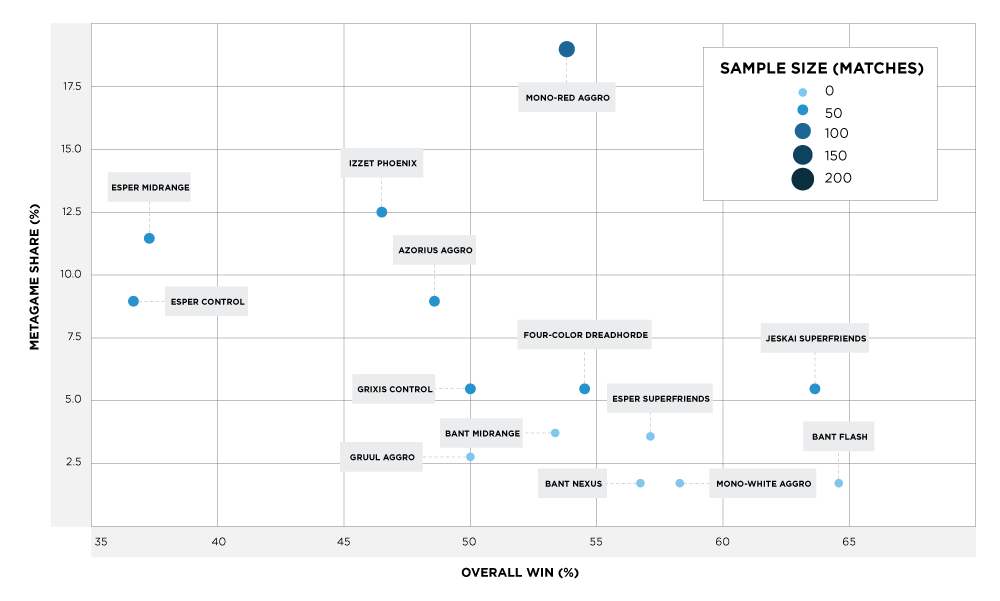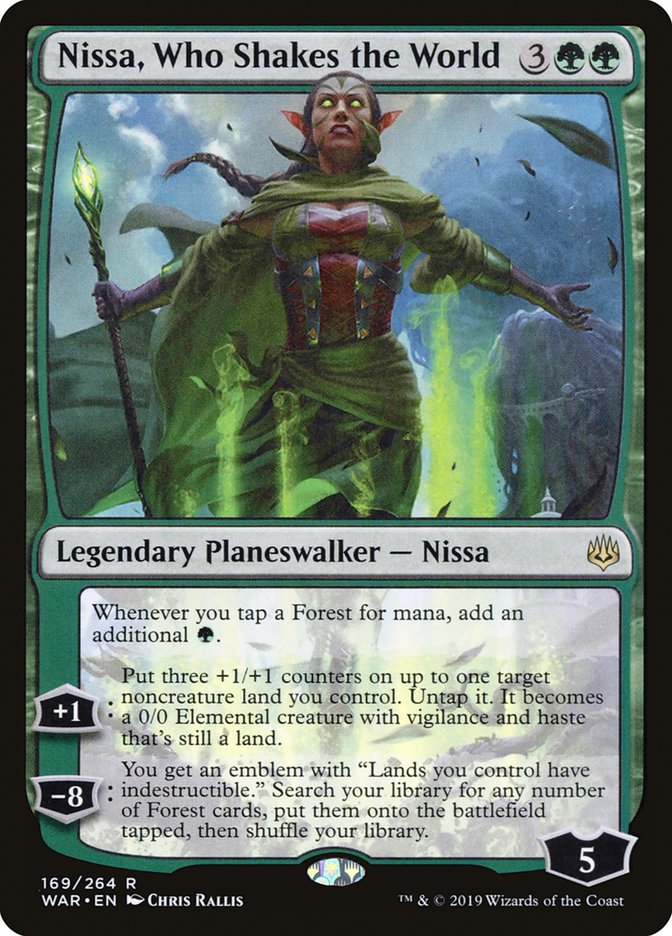Welcome to another Mox Insights report on the SCG Tour. Come with us to the hallowed halls of SCG Syracuse as we show you the decks bent and broken by the dread hordes of planeswalkers and the Dragons that rained fire on the competition.
A Game of Honed Decks
As a competitive player, which we presume you are if you’re reading this article, it’s important for you to understand that the way the metagame moves has radically shifted.
When we began tracking Modern Grand Prix results in 2018, you could generally anticipate some motion of the rise and fall of decks: Bant Spirits’s decline was paralleled by the rise of Izzet Phoenix. Ironworks’s win-rate dipped as it evaded the first Banned and Restricted announcement in November and new players picked it up, but rebounded in Grand Prix Oakland. Paper tournaments marked systemic shifts.
The publication of Magic Online results through biweekly dumps of Magic Online League 5-0s also led to periodic shifts, as players would refer to those publications as reliable dispersal of information to the wider community. Some people were deeply tuned into what was performing well on MTGO by the League results. Imagine an upside-down funnel: MTGO grinders and professional players would work on new decks and shift the metagame. Over time, that information would percolate and spread throughout the community: a new deck arises in the metagame and the metagame shifts in response.
MTG Arena and social media has changed that dramatically. If you weren’t plugged into Twitter and Twitch, some of the decks from Day 2 of SCG Syracuse might have come from left field. A little over a week before the event, John Rolf posted an early iteration of the Jeskai Superfriends-style deck that would later win the entire tournament. And then even closer to SCG Syracuse, Ondrej Strasky tweeted what would be one of the breakout decks of the weekend: Four-Color Dreadhorde.
Had a big success in high Mythic with this deck built by the powerhouse duo of @StanCifka and @IvanFloch_. Big props to them, because this deck is sweet as hell! I’m #3 Mythic now, come watch me get #1! https://t.co/SSf20H8Tmj pic.twitter.com/8cMucGAZKD
— Ondřej Stráský (@OndrejStrasky) May 15, 2019
This deck blends the midrange core package of green explore creatures with a planeswalker package. Wildgrowth Walkers would provide the life fuel and Command the Dreadhorde would vault over the top of any midrange-style mirror, with a heavy planeswalker package to fight back against control. If you approached this tournament with Esper Midrange or Esper Control as two of the best decks in the format, you were asking to get run over by these upstarts.
As a competitive Magic player, you need to change the way you digest information. MTGO Leagues, especially for Standard, are simply not reliable indicators of where the metagame is moving because the Standard metagame is churning thanks to the Arena ladder. What can you do to stay ahead of the pack? Reading this report is a good start. For more up-to-date information, especially at high Mythic ranks, we recommend @arenadecklists. Currently, there is no better source for learning what innovation is happening at the top of competitive Magic.
Bringing Fire and Blood
Before we discuss any of the major archetypes, we should point out the persistence of Mono-Red Aggro. The conventional knowledge that Mono-Red Aggro is the deck to play Week 1 held true, but the fact that Mono-Red continued to perform admirably even as it saturated the field and was on most players’ minds is impressive. Holding steady in the metagame share with a 54% win rate, even after the commanding finish in the first week of the War for the Spark Standard format, Mono-Red has hit the sweet spot for the “best deck” in terms of metagame share.
While it’s unlikely to be the powerhouse it was at the end of last season, Mono-Red is still a deck that players need to respect, as long as Mono-Red players are also adapting to the metagame. Tibalt numbers were up across the board as players adjusted to the anticipated popularity of Esper Midrange and Esper Control. Smarter players were also upping their Legion Warboss numbers to prepare to fight the latest contender for the throne of Standard.
Along the bottom of this axis was Jeskai Superfriends, the undisputed breakout deck of this tournament in the hands of Team Lotus Box with a whopping three copies in the Top 8 – numbers that would make Modern players cry out for the deck to be banned.
Planeswalkers (18)
- 2 Karn, Scion of Urza
- 1 Teferi, Hero of Dominaria
- 4 Teferi, Time Raveler
- 3 Saheeli, Sublime Artificer
- 4 Narset, Parter of Veils
- 4 Sarkhan the Masterless
Lands (25)
Spells (17)
Sideboard

You should expect many players to be picking up Zan Syed’s list as stock, but know that there will be customization and moving in the side. We’ll return to this list and why it’s good later on.
Bent and Broken
| MONO-RED AGGRO | 17-10 | 15-7 | 8-7 | 8-3 | 4-7 | 5-2 | 6-4 | |
|---|---|---|---|---|---|---|---|---|
| IZZET PHOENIX | 10-17 | 12-2 | 7-4 | 1-3 | 0-4 | 4-3 | 3-5 | |
| ESPER MIDRANGE | 7-15 | 2-12 | 5-2 | 4-5 | 1-4 | 5-3 | 2-5 | |
| AZORIUS AGGRO | 7-8 | 4-7 | 2-5 | 3-5 | 5-3 | 2-3 | 2-2 | |
| ESPER CONTROL | 3-8 | 3-1 | 5-4 | 5-3 | 1-8 | 1-4 | 2-3 | |
| JESKAI SUPERFRIENDS | 7-4 | 4-0 | 4-1 | 3-5 | 8-1 | 1-1 | 1-2 | |
| GRIXIS CONTROL | 2-5 | 3-4 | 3-5 | 3-2 | 4-1 | 1-1 | 2-3 | |
| FOUR-COLOR DREADHORDE | 4-6 | 5-3 | 5-2 | 2-2 | 3-2 | 2-1 | 3-2 | |
|
MONO-RED AGGRO
|
IZZET PHOENIX
|
ESPER MIDRANGE
|
AZORIUS AGGRO
|
ESPER CONTROL
|
JESKAI SUPERFRIENDS
|
GRIXIS CONTROL
|
FOUR-COLOR DREADHORDE
|
| 80 | |
| 70 | |
| 60 | |
| 50 | |
| 40 | |
| 30 | |
| 20 |
Esper was the biggest winner of SCG Richmond; we noted that it posted excellent win rates against the field and had a smorgasbord of flexibility against the field. All that changed last weekend.
|
Archetype |
Win Rate |
|
Mono-Red Aggro |
54% |
|
Izzet Phoenix |
47% |
|
Esper Midrange |
36% |
|
Azorius Aggro |
48% |
|
Esper Control |
37% |
|
Jeskai Superfriends |
64% |
|
Grixis Control |
50% |
These were the Top 8 decks by popularity. Of these Top 8, only two were above 50% in win rate; the tournament was extremely ready for Esper strategies, and not even Phoenix’s ability to counter planeswalker strategies kept it running against.
This lion still has claws, however.
Planeswalkers (19)
- 4 Teferi, Hero of Dominaria
- 2 Dovin, Hand of Control
- 1 Liliana, Dreadhorde General
- 4 Teferi, Time Raveler
- 3 Kasmina, Enigmatic Mentor
- 4 Narset, Parter of Veils
- 1 Ugin, the Ineffable
Lands (25)
Spells (16)

Tomajko’s list was not only the top-finishing Esper list of the tournament, it’s our pick for one of the best called shots for someone prepared for the metagame as it was moving. Tomajko emphasized The Elderspell, a card that has been steadily rising and moving into Esper maindecks.
The Metagame Is Dark and Full of Terrors
While Esper wasn’t a color archetype that performed incredibly well overall, this tournament remained about Teferi, Time Raveler. This card has likely had a larger impact on the Standard metagame than Nexus of Fate for a variety of reasons. We wanted to highlight one of the best pieces of Magic theory written in the past three years by current Play Design member Michael Majors when he talked about traction.
After reading that article, you can start to understand why the Jeskai Superfriends archetype emerged as a strong archetype from this weekend. Teferi, Time Raveler is a little bit of Reflector Mage and a little bit Defense Grid. Not only does he help you retain traction on the battlefield, he slows down your opponent’s mana-efficient ways of answering him and dealing with the tempo loss he presents. Teferi, Time Raveler allows the Jeskai Superfriends player to develop on the battlefield and then turn the corner, using Sarkhan the Masterless to close the game. Teferi, Time Raveler has also vastly reduced the efficiency of counterspells in the format. If, for example, you’re still playing Absorb in Esper Control, you have never been further behind the metagame.
The concept of traction has literally never been more relevant to contemporary Magic play, as we find ourselves with more planeswalkers than has ever been possible in Magic’s history. The very design of passive abilities on those planeswalkers further ensures traction – ever try drawing answers to a Narset, Parter of Veils? One draw step a turn isn’t enough.
With that in mind, we wanted to offer some recommendations for cards to build around and explore that have strong potential to attack the metagame.
Currently, Nissa, Who Shakes the World is being iterated on in a variety of shells. What began in Simic Mass Manipulation decks is now being iterated on in Mono-Green decks. Be prepared for the shift to hard ramp strategies backed by Hydroid Krasis to keep the fuel running.
On the other end of the spectrum, Gruul decks have a chance now that Esper decks have had to completely redesign their approach to the game thanks to Teferi, Time Raveler. When everything plays at sorcery speed, haste creatures are broken. Gruul also boasts a solid win rate versus Mono-Red, one of the less-discussed pillars of this format. From the angle that isn’t going over the top, we expect an uptick in aggressive, large creature Gruul decks.
And Now Our Watch Has Ended
We’ll be back next week to discuss the first major tournament with War for the Spark Modern and I hope you bought your copies of Karn, The Great Creator already. We’re not Chas Andres, but we would be remiss if we didn’t mention that this will be the first time Karn, The Great Creator has been seen on camera, and we’re confident it will have an impact on the format, based on the initial MTGO League and Challenge results. We also expect Narset, Parter of Veils and Teferi, Time Raveler to make a tremendous impact on Modern, even as Modern Horizons is right around the corner and similarly poised to have a tremendous shake-up of what seemed like a solved meta just a month ago.
Until next week!



